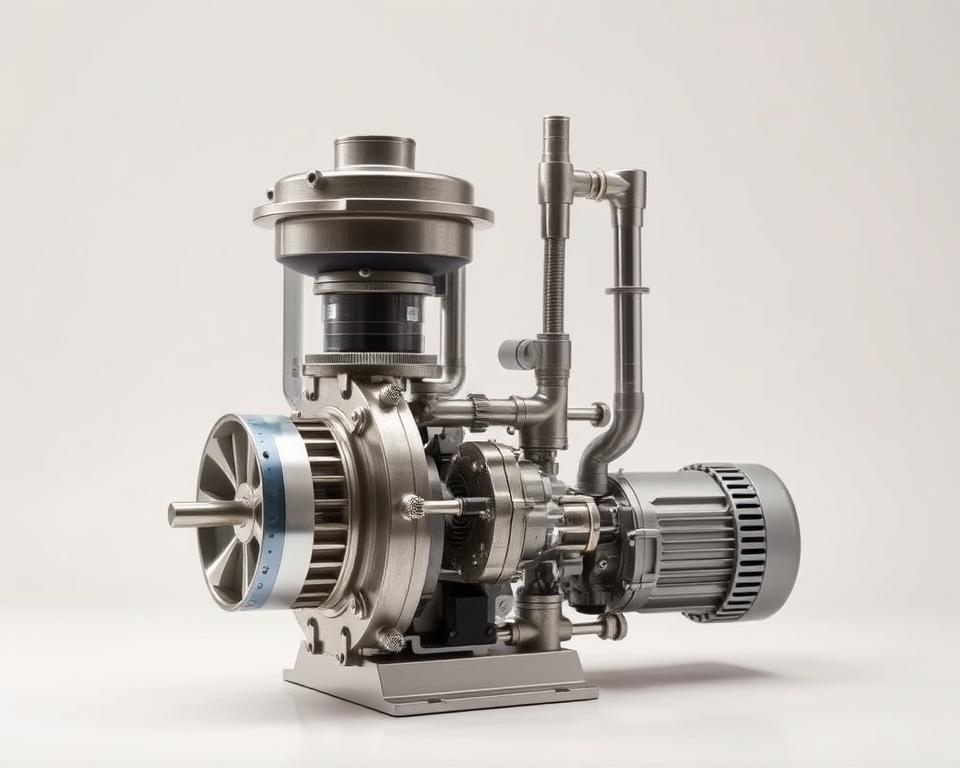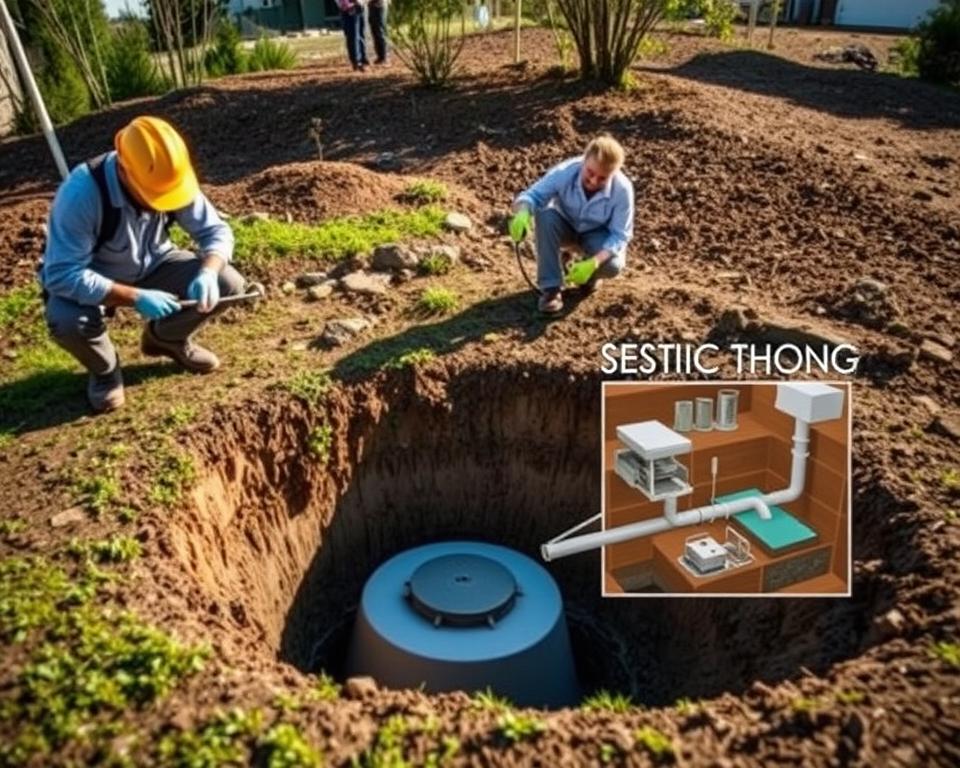Underground Septic Pump: Crucial Resource & Tips
Did you know over a quarter of American homes use septic systems for sewage management? This makes the basement septic pump essential to keeping your home secure and dry. It moves wastewater and excess water to the septic tank, especially in basements prone to water accumulation. Being aware of how these pumps work can save you effort and money.
Consistent maintenance of your septic pump is vital to prevent expensive repairs and keep it running well. In this resource, we’ll cover the basics of installing, maintaining, and replacing septic pumps. By the end, you’ll understand how to keep your cellar dry and preserve your home.
Comprehending the Basement Septic Pump
The basement septic pump is essential to handling wastewater in homes with a basement. It’s important to understand how it works to keep the system running well and prevent problems.
What is an Underground Septic Pump?
A basement septic pump is a appliance made to move wastewater from the home’s lowest spot, usually the basement. It rests in a sump pit, which holds surplus sewage or water. This pump is essential for homes beneath the septic system’s level, making sure waste is transferred away properly.
How Does a Basement Septic Pump Work?
The pump works by a simple yet functional process. When wastewater fills the sump pit, a float switch notices the water level rising. This activates the septic tank pump to start, sending the wastewater to the local septic system. This self-activating action is key to prevent flooding and damage, keeping the home safe. Being aware of how it works helps homeowners spot and fix problems early.
Picking the Correct Basement Septic Pump
Choosing the appropriate sewer tank pump near me is vital for homes with septic systems. It’s important to look at several attributes. These qualities ensure the pump matches your needs and the environment.
Important Features to Keep in Mind
When picking a basement pump for septic systems, take into account these characteristics:
- HP: The pump’s capacity affects how much water it can process.
- Kind: Select between submersible and pedestal pumps based on space and water depth.
- Durability: Look for pumps made of components that don’t corrode or wear out easily.
- Water Flow: Make sure the pump can move enough water per minute for your home.
- Backup Options: Consider pumps with battery backups for power outages.
Best Brands and Models Available
Many brands offer reliable pumps for different needs. Here are some leading names:
| Brand | Model | Power | Type | Unique Qualities |
|---|---|---|---|---|
| Zoeller | Model 98 | 0.5 HP | Submersible | Durable cast iron structure |
| Liberty Pumps | LE51A | 0.5 HP | Submersible | Simple service access |
| Wayne | RTP50 | 0.5 HP | Pedestal | Corrosion-resistant materials |
Knowing key features and top brands helps homeowners choose the most suitable basement septic pump. This thoughtful choice improves performance and cuts down on problems. It ensures the pump works well for its entire life.
Instructions for Basement Septic Pump Installation
Installing a basement septic pump demands precise planning and understanding the key steps. Before commencing, homeowners should examine their basement’s layout for the most suitable spot. They must also consider the electrical and drainage systems nearby. Having the appropriate tools and materials prepared makes the installation go smoother.
Pre-Installation Steps for Installation
Here are the steps to prepare for a basement pump installation:
- Review local plumbing and building codes to ensure compliance.
- Assess your basement layout for the best pump location.
- Verify access to a dependable electrical source for pump operation.
- Gather necessary tools such as a drill, wrenches, and sealing materials.
- Read the manufacturer’s installation instructions in full.
- If unsure, ponder consulting a professional for advice on installation.
Proper planning is key to successful septic pump maintenance after installation. These steps aid avoid future problems and make the pump last longer. By being thorough and diligent, homeowners can get the most out of their new basement septic pump.
Maintaining Your Basement Septic Pump
Keeping your basement septic pump in top shape is vital to its long life and efficiency. Routine checks can spot small problems before they escalate into big repairs. It’s important for homeowners to have a schedule that includes checking the pump and being aware of when it needs service.
Scheduled Maintenance Suggestions
- Inspect the sump pit often for debris that could obstruct the pump.
- Test the pump’s operation at least once a month to confirm it starts and stops properly.
- Check electrical connections to keep the pump running efficiently.
- Clean the pump inlet and inspect the float switch for any blockages.
- Watch the quality of the effluent; bad smells or cloudy water could indicate a bigger issue.
Signs That Your Pump Demands Service
Understanding when your basement septic pump needs service can prevent bigger issues later. Look out for these red flags:
- Strange noises from the pump, like grinding or rattling.
- The pump cycling more often than expected.
- Pump performance is sluggish, causing water to accumulate.
- Bad smells near the pump indicate it might not be working properly.
Prompt response on these signs can help address septic pump problems before they get worse. Consistent maintenance, thorough checks, and prompt action can preserve your home from water damage.
| Maintenance Activity | Frequency | Purpose |
|---|---|---|
| Inspect sump pit | Once a month | To clear debris and ensure proper pump performance |
| Test pump operation | Every month | To confirm the pump activates and stops right |
| Review electrical connections | Quarterly | To avoid breakdowns in performance |
| Clear pump inlet | Every year | To stop clogs and ensure optimal water flow |
| Water quality check | Every year | To detect signs of contamination early |
When to Change Your Basement Septic Pump
Understanding when to replace your septic pump is crucial for keeping waste disposal systems working well. You should consider replacing it if it’s over a decade old. Also, if it’s not working right, like cycling too much or not efficiently, it’s time to look into replacing it.
Look out for signs of wear or damage, like leaks, loud noises, or if it won’t activate. If your pump keeps getting clogged or has power issues, it’s wearing out faster. It’s wise to talk to a professional to see if fixing it or getting a new one is best for your system.
| Factor | Trigger for Replacement |
|---|---|
| Age of Pump | Over 10 years |
| Functionality Problems | Constant or unwarranted cycling |
| Noticeable Wear | Leaks, cracks, or rust |
| Power Issues | Repeated failures after outages |
| Obstructions | Frequent issues with blockage |
When thinking about replacing your septic pump, look at these signs. Taking action early keeps your home safe and your waste management system working properly.
Frequent Troubles with Cellar Septic Pumps
Basement septic pumps are essential to keeping waste management in control at home. Understanding common problems helps homeowners fix them quickly. This can stop bigger issues and help the system be more durable.
Comprehending and Troubleshooting Problems
Basement septic pumps face many difficulties. The most common issues include:
- Blockages from Debris: Items getting stuck can block the pump, halting waste from being removed.
- Motor Malfunction: The motor can fail over time, needing a inspection and maybe a new one.
- Switch Malfunctions: A faulty float switch can cause the pump operate wrong, not operate properly.
Checking these parts regularly helps identify problems early. Homeowners can look out for signs like unusual sounds or the pump working too much. This way, they can resolve things fast.
| Trouble | Symptoms | Fixes |
|---|---|---|
| Clogging | Pump operates but does not expel waste | Check and remove debris from pump intake |
| Engine Breakdown | Pump does not operate at all | Check power supply; replace motor if necessary |
| Switch Failures | Pump runs continuously or not at all | Check and swap faulty float switch |
Using a trusted service like All In Site Services ensures you get expert help for basement septic pump repairs. Quick action on problems keeps the system working efficiently. This keeps your home’s waste management system safe and dependable.
Conclusion
A basement septic pump is crucial for a home’s plumbing. It keeps water damage and sewage problems at bay by moving waste from the basement to the septic system. Being aware of how it works helps homeowners take care of their systems better.
Choosing the right septic tank pump is important for its long life and efficient performance. Think about the pump type, size, and where it’s positioned. Routine upkeep and prompt action if there are problems will make your home safer.
Homeowners who look after their septic system preserve their property and experience better living conditions. A working basement septic pump offers security.



